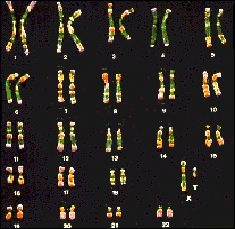What is Cancer?
Fig.2: This is Human Karyotype. The 22 pair of choronmosomes vary in their shape and sizes. They are given numbers from pair 1 to pair 22. Sex chromosomes are named as X and Y.
Fig.3: This is an imaginative figure of normal human cell. Note the positionof Nucleus, the chromosomes, the double helix of DNA and their base pairs.
Cancer is an age-old disease affecting mankind. It was recognised by ancient Egyptians as early as 1600 BC. Even ancient Indian Doctors like Sushrutha and Charaka identified this disease and named it as arbuda. It is increasing in an alarming pace from last 50 years because of rapid Industrialization, Urbanization and Modernization.
Our body is made up of billions of cells. Cells unite to form tissues. Tissues form organs. Organs form Organ systems, which finally form what we call whole body and life.
All the cells have same plan of construction but vary in certain aspects depending upon the organ where they are present and the function they are doing. A red blood cell is saucer shaped cell-carrying Oxygen and supplying to each and every cell of the body. A muscle cell is spindle shaped helping in locomotion. A nerve cell has an elongated structure helping in conduction of electrical impulses and participating in communication.
The billions of cells of the body that are the result of a single cell called zygote, which is the product of fusion of sperm with Ovum. Zygote multiplies repeatedly to form the whole body. Each and every cell has a nucleus (exception: Red blood cells). In the nucleus, there are 23 pairs of chromosomes. Each chromosome has several genes and each gene is made up D.N.A, which is made up of several base pairs, which are nothing but various Chemical molecules!
Genes are the blue prints of our life. All the details concerned with the various functions of the body including re-productions are present in the form of specific codes in these genes. The genes you pass along with your spouse decide whether your child will have blue eyes, curly hair or fair colour. Also some diseases are transmitted to offspring through genes.
A cell is predetermined as to how many times it has to re-produce in its lifetime. Cancer develops when cells in a part of the body begin to grow out of control. This is an abnormal feature resulting in the formation of abnormal cells. Although there are many kinds of cancer, they all start because of out-of-control growth of abnormal cells.
Normal body cells grow, divide, and die in an orderly fashion. During the early years of a person's life, normal cells divide more rapidly until the person becomes an adult. After that, cells in most parts of the body divide only to replace worn-out or dying cells and to repair injuries.
Because cancer cells continue to grow and divide, they are different from normal cells. Instead of dying, they outlive normal cells and continue to form new abnormal cells. Cancer cells develop because of damage to DNA. Most of the time when DNA becomes damaged the body is able to repair it. In cancer cells, the damaged DNA is not repaired. People can inherit damaged DNA, which accounts for inherited cancers. Many times though, a person’s DNA becomes damaged by exposure to something in the environment, like smoking.
Cancer usually forms as a tumour. Some cancers, like leukaemia popularly known as Blood Cancer, do not form tumours. Instead, these cancer cells involve the blood and blood-forming organs and circulate through other tissues where they grow.
Often, cancer cells travel to other parts of the body, where they begin to grow and replace normal tissue. This process is called metastasis. Regardless of where a cancer may spread, however, it is always named for the place it began. For instance, breast cancer that spreads to the liver is still called breast cancer, not liver cancer.
Not all tumours are cancerous. Benign (noncancerous) tumours do not spread to other parts of the body (metastasize) and, with very rare exceptions, are not life threatening.
Different types of cancer can behave very differently. For example, lung cancer and breast cancer are very different diseases. They grow at different rates and respond to different treatments. That is why people with cancer need treatment that is aimed at their particular kind of cancer.
Cancer is curable if it is detected early. Today, millions of people are living with cancer or have had cancer. The risk of developing most types of cancer can be reduced by changes in a person's lifestyle, for example, by quitting smoking and eating a better diet. The sooner a cancer is found and treatment begins, the better are the chances for living a productive life for many years.
- Dr.N.Someswara




1 Comments:
At 3:22 PM, Anonymous said…
Anonymous said…
I say briefly: Best! Useful information. Good job guys.
»
Post a Comment
<< Home